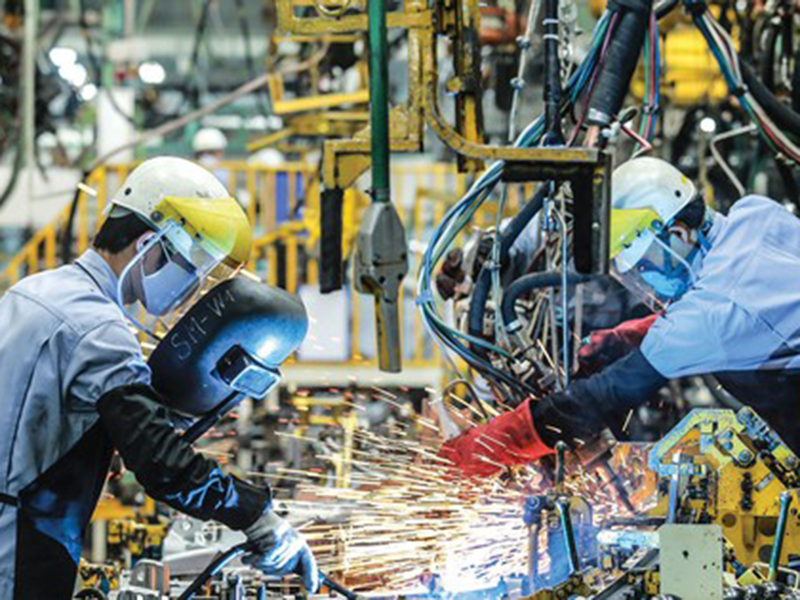News - Events
Home
News - Events
Industry grows thanks to "traction" from processing and manufacturing

- 04/01/2022
- News - Events

Data reported by the Ministry of Industry and Trade shows that the added value of the whole industry in the first nine months of 2021 increased by 4.45% over the same period last year (in the first quarter, it increased by 6.29%; in the second quarter, it increased by 11.18%. ; and the third quarter decreased by 3.5%).
In which, the processing and manufacturing industry increased by 6.05% (in the first quarter, it increased by 8.9%; in the second quarter, it increased by 13.35%; in the third quarter, it decreased by 3.24%); mining industry decreased by 7.17%.
From the above statistics, it can be seen that the manufacturing and processing industry continues to play a leading role, creating the largest added value for the industrial sector and the overall spillover effect on the quality of growth. economy.
Notably, the structure of industries is having a positive change when the proportion of the processing and manufacturing industry is increasing, while the proportion of the mining industry tends to decrease. This is in line with the industry restructuring orientation.
According to the Ministry of Industry and Trade, in recent years, the export turnover of industrial products has increased rapidly, accounting for more than 90% of the total export turnover of the country, of which the proportion of processing and manufacturing industrial products are increasing.
Many industrial products such as leather and footwear, textiles, and electronics have high export rankings compared to the region and the world.
However, the above report also points out a number of limitations of the processing and manufacturing industry, which are mainly still concentrated in the low-tech industry and in the processing and assembly stage, with low added value.
The main export industries such as textiles, apparel, footwear, and electronic assembly have grown rapidly, but mainly thanks to the use of cheap labor and imported raw materials, this has greatly affected the increased quality. growth of the economy.
Notably, while the contribution to industrial production value of foreign direct investment (FDI) enterprises is increasing, the contribution of state enterprises is decreasing.
This situation has also been pointed out by the Vietnam Association of Mechanical Enterprises, Vietnam is very short of large private enterprises in the field of processing and manufacturing industry.
While the processing and manufacturing industry plays a particularly important role, it is the driving force leading the economy to grow, helping to avoid the risk of falling behind and participating in the global value chain.
Currently, there are only a few large enterprises operating in the field of automobile production such as Truong Hai, VinFast, Thanh Cong, etc., but they have not yet reached the world-class level.
Therefore, Vietnam's processing and manufacturing industry is still heavily outsourced, heavily dependent on foreign countries, has not yet occupied strong positions in the global supply chain, and lacks a foundation for development. develop independently.
This makes the domestic processing and manufacturing industries highly dependent on the import of raw materials, intermediate products, production machinery and equipment, making domestic production activities lack of autonomy. vulnerable to political - economic - social fluctuations in the world and in the region (of which the recent heavy impact of the Covid-19 epidemic on the manufacturing sector is a typical example).
In the past 9 months, due to the impact of the Covid-19 epidemic, the production index of some localities decreased sharply compared to the same period last year. Specifically, HCMC decreased by 12.9%; Ben Tre decreased 11.2%; Dong Thap down 9.9%; Can Tho decreased by 9.8%; Khanh Hoa decreased by 9.5%; Tra Vinh down 7.3%; Ba Ria - Vung Tau down 5.3%; Vinh Long down 4.5%.
In the opposite direction, a number of localities had an increase in industrial production in the first nine months of 2021 compared to the same period last year, including: Ninh Thuan with an increase of 32.6%; Dak Lak increased by 25%; Hai Phong increased by 19.7%; Nghe An increased by 18.3%; Gia Lai increased by 17.4%; Ha Tinh increased by 16.6%; Thanh Hoa increased by 15.3%; Quang Ngai increased by 14.9%; Ha Nam increased by 14.4%; Binh Phuoc increased 14%.
Author: An Ha
